7 February 2017
I was a bundle of energy and excitement as I boarded the little dive boat, our exploration vessel for the day’s journey through the islands of the greater Raja Ampat region. First stop? Manta Sandy, a prominent dive site and known manta cleaning station. It was about a 45 minute boat ride there over gleaming turquoise waters. Throughout the journey, our dive group was all smiles and wind-blown hair as we took in the vivid landscape that surrounded us.
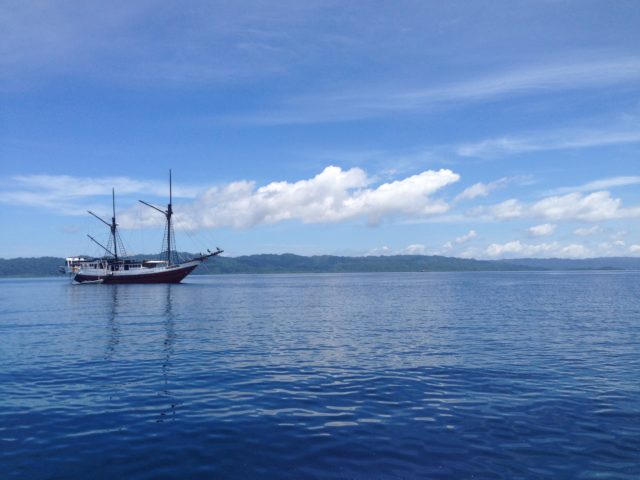
Manta Madness:
The boat slowed to a crawl as we approached the dive site. We were all familiar with the routine by this point. Before any of us would get in the water, our dive guide, would jump in to check the conditions, the location (none of the dive sites are marked, the guides go off memory alone), and in this case, check for mantas. If he didn’t see mantas, or if there were too many divers already at the site, we would re-route to a more favorable location. It is this kind of flexibility and consideration that set this dive team apart from any I’d been with prior. They would go above and beyond to make sure we had the best experience possible.
There weren’t many manta at the site when we arrived, so we re-routed to another area to snorkel around for a bit before checking the site again. We could see manta here and there from afar, their wings breaking the glassy surface of the water, so we knew they were in the area, just not where we could easily view them. The boat dropped us close to where we’d last seen their wings breaking the surface. Masks and fins donned, we all booked it in the direction of the massive fish. Now and again, the guides that remained on the boat would point and shout new directions at us, and we’d all do a 180 in the direction of the new spotting. It was a rather comical experience. In the end, I didn’t see any manta while snorkeling, but I did see an eagle ray and a couple of black-tip reef sharks.
All tired out, we climbed back in the boat to head back to the dive site. On the way, a huge reef manta approached our boat, skimming the water’s surface. Charlotte, a fellow traveler, was so excited she literally leapt from the boat into the water, gopro ready, to get that up-close encounter. The rest of us watched in mingled awe and amusement as the gentle giant slowly approached her, head on. We also watched as Charlotte slowly tried to back away, a bit startled by the boldness of the manta, as she later recounted. It was only a mere few feet away from her before it dove back to the depths.
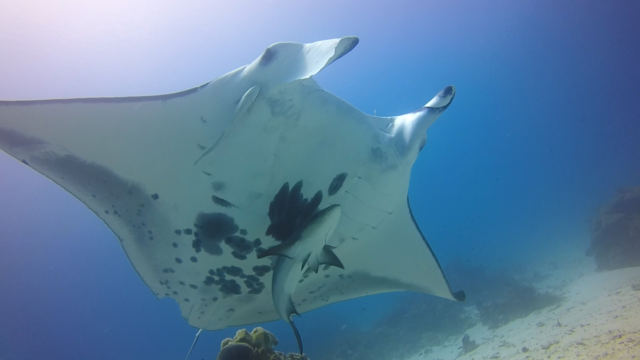
Not long later, we were all below the waves at Manta Sandy. Here we all sat lined up on the sandy bottom as we watched manta gliding through the cleaning station in front of us. Many of the dive guides from the region had worked together over time to build a low rock wall on the sea floor that indicated where divers could watch the cleaning in process without disturbing the manta present (well, as little disturbance as possible). Whenever an uninformed diver crossed to the wrong side of the wall, a dive guide would go fetch them back. An awesome example of dive shops working together to help minimize disruption of marine ecosystems, while still allowing divers to enjoy the wonders of the sea.
Tea time was held on the little island of Arborek before we left to explore the bays and inlets of the archipelago.
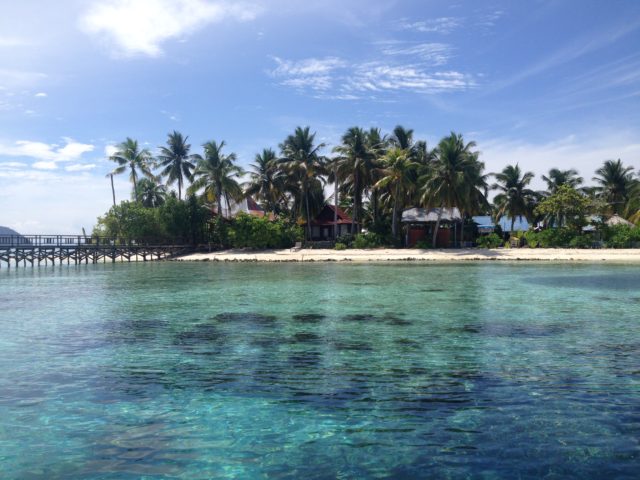
The Croc Lair:
Now a couple of days before, when the one of the managers was explaining the day trip’s itinerary to us, we were told that there would be two dives during the excursion and boat tours of other areas in between. Following his rundown, he paused to look over the group:
“You two were here last year weren’t you?” He addressed the young couple standing next to me.
“Yes,” they replied, “and didn’t we snorkel between dives last time?”
“Yeah, so we stopped snorkeling about a year ago because we spotted a rather large salt water crocodile at the snorkel site.”
At this my eyes widened, and my ears perked up. “There are salt water crocodiles here?”
“Yes, we get them around here.”
I processed that for a second before asking the all important follow-up question: “What is ‘rather large’?”
“Six meters…”
Flash forward to the excursion. Now just because we couldn’t snorkel in the croc lair, didn’t mean we weren’t going to tour it. So following Arborek island, the captain took us into the labyrinth of waterways that now supposedly housed an 18 foot reptilian giant. My previous level of excitement was enhanced by the adrenaline now running through my system at the thought of seeing such a beauty up close. Though the knowledge that that crocodile was just about as big as the boat we were in didn’t escape anyone’s notice.
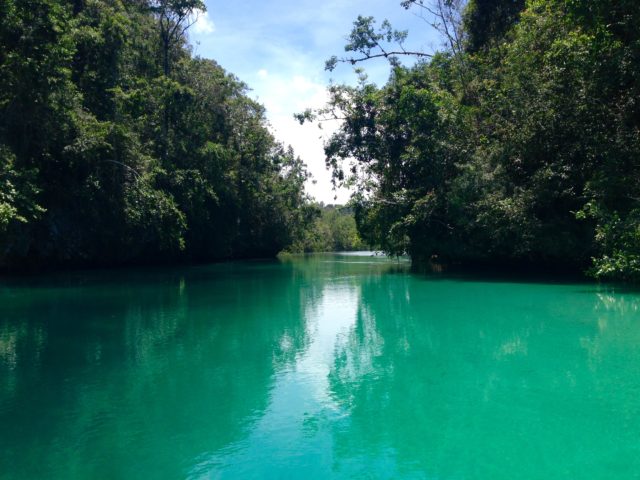
I sat perched on the bow of the boat, scanning the murky waters and jungle-lined banks for activity, channeling my inner Steve Irwin. Every floating log looked like a croc lurking just beneath the water. Every mossy rock on the shallow banks, a sleeping giant. When we didn’t initially spot any reptiles in the water, the captain started checking the few banks large enough for a croc to haul out on. To do this he literally pulled the boat right up into the vines and foliage that shaded the banks from view. Should there have been a croc there, this would place the bow of the boat only feet from it, the bow that I was perched on…
“Umm, guys?” I looked anxiously at the other passengers seated next to me on the bow of the boat, then at the boat crew safely seated at the back of the boat. “What exactly is our exit strategy here…?” The boat continued to pull in closer to the still obscured bank. “No, seriously. Guys…?” Just before I was about to bolt to the back of the boat, the vines cleared and revealed an empty mud bank. No croc in sight. It took a while before my heart rate slowed to a healthy rhythm.
Much to my disappointment, we never found the illusive mammoth crocodile, but the search was still one of the highlights of the trip.
Le Passage & More:
Next stop, Le Passage (read with thick French accent), a narrow waterway connecting two bays. The ripping currents that roll through make for an extreme niche habitat for flora and fauna that have adapted to thrive in such unique environmental conditions, it also makes for a wild ride of a drift dive.
The guides did a once through of the passage to assess the conditions before dropping us at one end. Floating in the turbid water, I couldn’t help but think of the murky water of the croc lair that we’d just left. I wasn’t the only one thinking this:
“Are we sure there’s no salt water crocodiles here?” one of the other divers asked, only half joking.
“Even if there are, it’s ok, they’ll go for Charlotte first since she’ll be floating at the surface.” That earned laughs from the divers, and a reproachful look from Charlotte who had opted to snorkel rather than dive the site.
By this point, I had a lot of trust in our dive guides. They’d done an amazing job of making us all feel safe and comfortable during excursions, and confident in their knowledge of the local dive sites and wildlife. So when we were told we’d be starting the dive with a shallow pass-through into an open-air lagoon-like area, I happily followed along. That is, until I saw how narrow the chimney-like pass-through actually was… Our little Papuan dive guides had no trouble squeezing through, but it wasn’t such a breeze for the rest of us. I was uncomfortably aware of the potentially sharp and stinging invertebrates that covered the walls of the chimney as I tried my very best to squeeze through without causing any damage to them or myself. When I finally reached the surface, I breathed a deep sigh of relief before ripping out my regulator and pulling off my mask:
“Yo, what was that?!” I yelled, half laughing, at our dive guide. He only smiled back at me, before laughing at my indignation himself.
By that point the rest of the group had surfaced around us: “Well that was…narrow. I think my tank might have some new scratches on it.”
“Please, please tell me we don’t have to go back out that way,” I pleaded.
Thankfully we did not. We all floated for a time, taking in the remarkable silence and stillness of the little cavern we found ourselves in. Leaves that had fallen from the jungle canopy above floated around us, illuminated by the sunbeams streaming through the treetops. All too soon, our dive guide called for us to follow him out of the cavern and back into the passage. Back below the water, I could now see a much larger opening that led back out to where we’d started. Next to that was another very narrow pass-through that led to the same place. Of course, our dive guide chose to lead us through the later. Not about to go through that experience again, I took the high road and met them at the bottom. When the guide saw that I had skipped the pass-through, he mimed questioning why, to which I just shook my head at him. He got the message, as evident from the surge of bubbles emitted from his reg due to laughter.
The rest of the dive blew by (literally) by in a wild whirl of color. Though the visibility was poor compared to our previous dives due to the sediment churned up by the current, the marine life was spectacular. I’ve never seen such beautiful and massive soft corals, which came in every delicate shade of pastel you could imagine. Nor such large barracuda and trigger fish…it was quite startling to come whipping around a divide in the passage to come face to face with these potentially aggressive fish. But before we knew it, we’d past them as well. It seemed like no time before we were all at the surface again, taking off our masks. We drifted lazily, floating on our backs while we waited for the boat to find us. To our relief, we also discovered that Charlotte had not become croc chow while we’d been diving. It was a serious concern.
We lunched at possibly the most remote homestay in existence. Ok, I’m sure that’s far from true, but it sure felt like it. It was the home of a Papuan family, built in traditional fashion, perched on stilts that elevated it just above the water’s surface. It was also the only structure for what must have been miles, and could only be reached by boat. Schools of fish lingered beneath the dock, visible through the crystal clear water, and the island that flanked the home was nearly straight vertical, covered in dense vegetation.
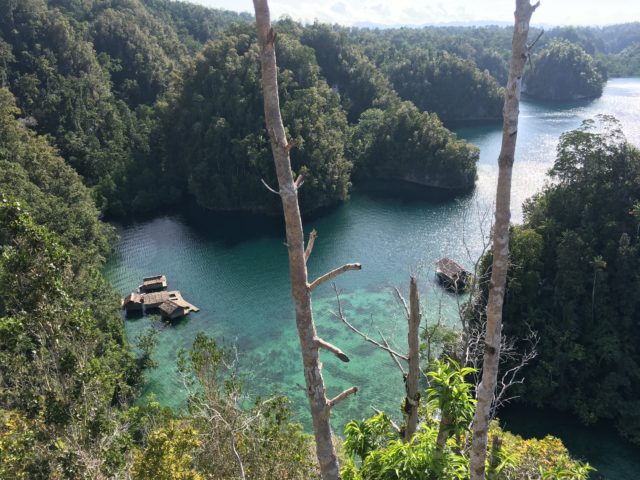
We scaled this after lunch. It was more of a climb than a hike up makeshift stairs and ladders that the homestay’s owner had constructed himself. He’d also constructed the lookout platform at the top of the island that offered 360 panoramic views of the archipelago below. Perhaps unwisely, we fit our entire group onto this precarious platform, carefully rotating positions to allow everyone their photo op.
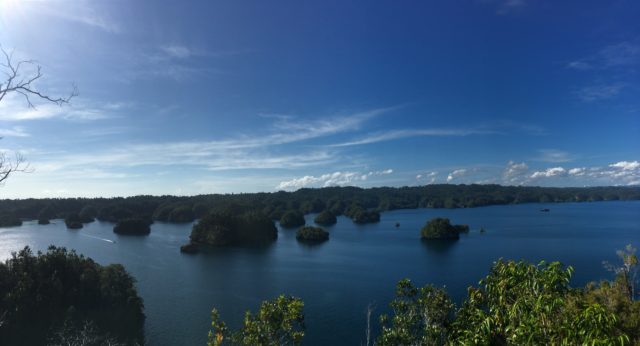
The rest of the day passed in a sleepy haze. I was exhausted from the day’s adventures, and ready for a long nap. Our route home took us zigzagging through the beautiful mushroom islands of Raja Ampat, rounded islands aptly named, for when the tide fell and exposed their water-worn bases they looked just like mushrooms sprouting from the sea.
All-in-all, it was a full and incredible day. It was also an awesome opportunity to explore more of the beautiful archipelago of Raja Ampat, explore more that just what lies beneath the waves.